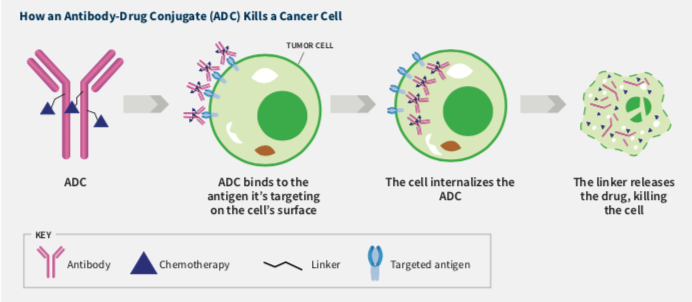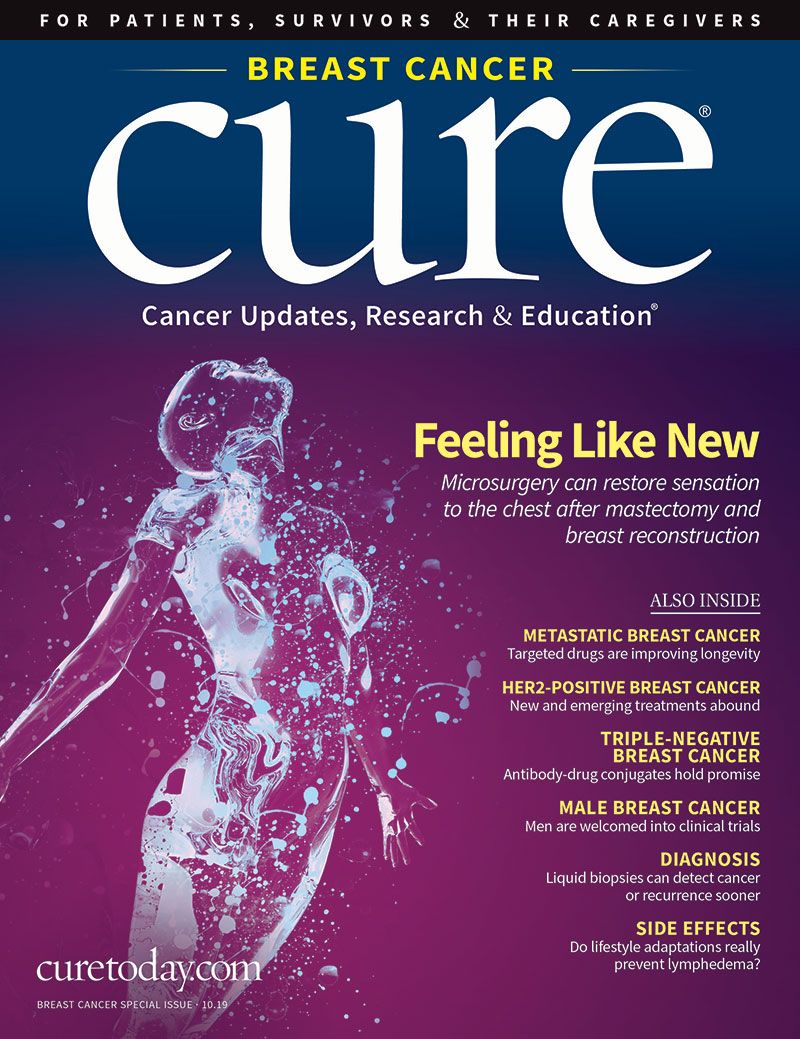Publication
Article
CURE
Pairing Up Against Triple-Negative Breast Cancer
Author(s):
Linking a targeted drug to a chemotherapy shows promise for treating metastatic triple-negative breast cancer.
Anitbody-drug conjugates (ADCs), a two-in-one drug treatment strategy, might help meet the pressing need for new therapies for metastatic triple-negative breast cancer (TNBC), according to Dr. Aditya Bardia, an assistant professor of medicine at Harvard Medical School and attending physician in medical oncology at Massachusetts General Hospital in Boston.
ADCs consist of an antibody, which homes in on proteins that sit on the surfaces of cancer cells, and a potent chemo- therapy equipped to kill those cells. A linker joins the two drugs and releases the chemotherapy once it has entered the cell and the target has been reached. The ADC furthest along in development for TNBC is sacituzumab govitecan. The Food and Drug Administration (FDA) has already approved another, Kadcyla (T-DM1), to treat HER2-positive breast cancer, a different subtype.
The promise of this class of drugs in TNBC represents a change in the way scientists characterize the disease. Until now, TNBC was defined by the fact that it would not respond to targeted drugs because it is not driven by hormones or an overexpression of the protein HER2.

“Triple-negative breast cancer, as we know, is a mixed bag,” Bardia said during a presentation at the 36th Annual Miami Breast Cancer Conference® (MBCC). “It’s a diagnosis of exclusion. It’s defined by something it does not have, rather than something that it has ... but there are actionable targets in triple-negative breast cancers.”
Bardia explained the need for new treatments in TNBC: For cases that have recurred or become resistant to treatment, there is no standard chemotherapy regimen; responses to treatment are usually short and followed by rapid relapse; and the disease commonly spreads to the gut and brain. With chemotherapy, the median time without disease progression is from 1.7 months to 3.7 months; the median overall survival from the onset of metastasis is 10 months to 13 months, Bardia said.
Against this backdrop, investigators are exploring strategies that take aim at targets in TNBC. Bardia said these targets fall into three main categories: cancer-driving genes such as BRCA and PIK3CA; intercellular signaling pathways such as the PI3K/AKT/mTOR and androgen receptor networks; and proteins on the surfaces of cancer cells, which allow drug delivery with ADCs.
The components of ADCs are “important considerations that could impact the efficacy/toxicity ratio” of an individual drug, Bardia said. One concern about side effects relates to ADCs’ apparent “bystander” effect, he said: “Some of the (chemotherapy) payload leaks from the cancer cell and affects cells that do not express that antigen” — in other words, healthy cells.
The precedent for ADC activity in breast cancer was set in 2013 with the FDA’s approval of Kadcyla, which linked a HER2-targeted antibody and a microtubule inhibitor and was approved for patients with HER2-positive, metastatic breast cancer who had previously received Herceptin (trastuzumab) and a taxane chemotherapy.
During his presentation, Bardia reviewed data for three emerging ADCs: sacituzumab govitecan (IMMU-132), which targets the protein TROP-2; ladiratuzumab vedotin, which targets LIV1; and trastuzumab deruxtecan (DS-8201), which targets HER2.
SACITUZUMAB GOVITECAN
In the ADC pipeline, sacituzumab govitecan has reached the most advanced stage of development. It combines SN-38, an active metabolite of the chemotherapy irinotecan, with a drug targeted against TROP-2, which is expressed on the cells of metastatic TNBC and many solid cancers. In preclinical studies, findings showed that the drug conjugate delivered up to 136-fold more SN-38 compared with standard irinotecan, Bardia said.
In a phase 2 trial, sacituzumab govitecan elicited a confirmed objective response rate (the percentage of patients whose treated cancer shrinks or disappears) of 33.3% in the 108 participants, which included one man. The median progression-free survival (the time from when treatment started until disease progressed) with sacituzumab govitecan was 5.5 months and overall survival was 13.0 months — all higher numbers than would be expected with standard chemotherapy drugs.
Responses occurred at a median of two months and lasted an estimated median of 7.7 months. Notably, patients were able to remain on sacituzumab govitecan longer than they had on prior therapies, suggesting that previous treatments had not made their cancer resistant to it, said Bardia, who is the lead investigator on the study.
The most frequently reported side effects, of any severity, were nausea (67%); neutropenia, a lack of sufficient neutrophils in the blood (64%); anemia (50%); diarrhea (62%); and fatigue and weakness (55% each), Bardia said. Events that were severe or medically significant but not life-threatening included neutropenia (26%), anemia (11%), fatigue/weakness (11%), diarrhea (8%) and nausea (6%). Life-threatening neutropenia was reported in 16% of participants. These side effects can occur with irinotecan because of the small amount of drug that leaks into the bloodstream but generally are less frequent and severe than those seen with regular chemotherapy.
Importantly, Bardia said, there were no reports of peripheral neuropathy (tingling and weakness in the extremities). That may be a noteworthy attribute if the tested drug is combined with other therapies that cause neuropathy.
The ADC is being explored in the multicenter phase 3 ASCENT trial (identified as NCT02574455 on clinicaltrials. gov) in patients with TNBC previously treated with at least two systemic chemotherapy regimens.
Although the FDA was evaluating sacituzumab govitecan under its priority review program, the agency decided in January to delay approval, raising questions regarding chemistry, manufacturing and control matters, according to Immunomedics, the company developing the drug. The company said it is working with the FDA to resolve the issues.
In response to a question, Bardia said no issues have been raised concerning the clinical data, and pending trials have not been interrupted.
LADIRATUZUMAB VEDOTIN AND TRASTUZUMAB DERUXTECAN
The target for ladiratuzumab vedotin is LIV1, a trans-membrane cell adhesion molecule highly expressed in metastatic breast cancer. The drug employs monomethyl auristatin E, a microtubule disrupting agent, as its chemo- therapy payload.
The ADC is being evaluated in an ongoing phase 1 study in patients with metastatic TNBC who have received at least two chemotherapies for inoperable, locally advanced or metastatic disease (NCT01969643).
In findings presented at the 2017 San Antonio Breast Cancer Symposium, the objective response rate to the treatment was 25% (15 of 60 patients). The median progression-free survival was 11 weeks and the median duration of response was 13.3 weeks. All-severity side effects included hair loss (40.7%), neutropenia (24.7%), vomiting (23.5%) and peripheral neuropathy (19.8%).
Bardia highlighted a third ADC under study: trastuzumab deruxtecan (DS-8201), which targets HER2 but has shown efficacy among patients with low HER2 expression. In a phase 1 study, the objective response rate to the drug was 50% (17 or 34) in patients with HER2-low breast cancer. It is also being tested in other malignancies that express HER2, such as stomach cancer.
Trastuzumab deruxtecan is being developed under a breakthrough therapy designation, which means the FDA will expedite its development for patients with HER2- positive, locally advanced or metastatic breast cancer who have been treated with Herceptin and Perjeta (pertuzumab) and have disease progression after taking Kadcyla.





